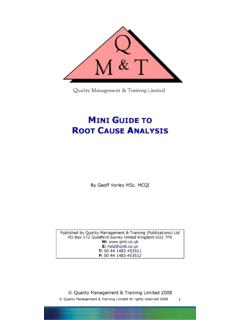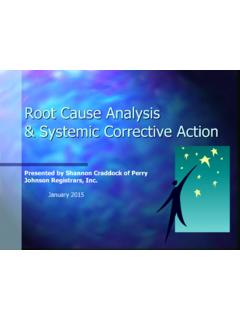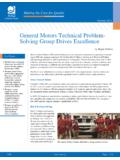Transcription of Content Sheet 14-1: Overview of Occurrence Management
1 Occurrence Management Module 14 Content Sheet 1 Content Sheet 14-1: Overview of Occurrence Management Role in quality Management systems Occurrence Management , or dealing with laboratory errors, is important in assuring good service from the laboratory. It is one of the twelve quality essentials, and must be addressed in laboratory quality Management . This module will describe and explain basic elements that are essential for developing an effective Occurrence Management program. Overview of the process Occurrence Management is a central part of continual improvement.
2 It is the process by which errors, or near errors (also called near misses) are identified and handled. The goal of an Occurrence Management program is to correct the errors in either testing or communication that result from an event, and to change the process so that the error is unlikely to happen again. Well managed laboratories will also review their systems and detect process problems that could possibly cause error at some time in the future, allowing for prevention of these errors. Definition An Occurrence is any event that has a negative impact on an organization, including its personnel, the product of the organization, equipment, or the environment in which it operates.
3 All such events must be addressed in an Occurrence Management program. Organization Personnel Equipment Purchasing & Inventory Process Control Information Management Documents & Records Occurrence Management Assessment Process Improvement Customer Service Facilities & Safety Occurrence Management Module 14 Content Sheet 2 Content Sheet 14-2: Sources and Consequences of Laboratory Error causes of laboratory error Some of the common causes of error in the laboratory are easily identifiable, and are also readily correctable.
4 For example, some errors may occur because staff are unclear about who is responsible for carrying out a particular task, so it may remain undone. To prevent these types of errors, individual responsibilities must be clearly defined and communicated. Other errors occur when procedures are not written or followed, and staff are not adequately trained. Written procedures serve as a guide for all staff, and help to assure that everyone knows what to do. It is essential to ensure that these written procedures are followed correctly.
5 Staff need to be trained on how to conduct the procedures, and if this training is neglected errors can result. There are many other sources of error, in addition to these which are frequently observed. While they often occur during pre- and post-examination processes, errors can occur throughout the testing process. Two useful studies for understanding sources of laboratory errors: 1 Retrospective data collection found Australian pathology laboratories had a transcription-error rate of up to 39% and an error rate of up to 26% for analytical results.
6 2A report from the College of American Pathologists in collaboration with the CDC Outcomes Working Group describes error stratification in the working process for clinical laboratories. In more than 88 000 defects, 41% were observed in the preexamination phase of testing, 55% in the post-examination phase, and only 4% in the examination phase. Pre-examination errors Some examples of pre-examination errors that are frequently seen include: collecting the wrong sample; mislabeling or failing to label the sample; storing the sample incorrectly prior to testing, so that the sample deteriorates; transporting the sample under conditions that damage the sample or that endanger staff and public safety; damaging the reagents or test kits by storing them improperly.
7 1 Khoury M, Burnett L, Mark A Mackay MA. Error rates in Australian chemical pathology laboratories. Medical Journal of Australia. 1996; 165: 128-130. Available at URL: 2 Bonini P, Plebani M, Ceriotti F, Rubboli F. Errors in laboratory medicine. Clinical Chemistry; 2002;48:691-698. Available at URL: See Table 1 in this reference. Occurrence Management Module 14 Content Sheet 3 Examination errors A list of common errors that occur during the testing process include: failing to follow an established algorithm; as an example, for HIV testing; reporting of results when the quality control material tests out of range; incorrect measuring of the sample or reagents; usually these are dilution or pipetting errors; using reagents that have been improperly stored, or after their expiration date.
8 Post-examination errors Many of the common laboratory errors occur following the testing of the sample, and some of these may be more difficult to detect. Common examples of these kinds of errors include: making a transcription error when preparing the report; producing a report that is illegible, usually caused by poor handwriting, but sometimes by damage to the report form; sending the report to the wrong location, which often results in complete loss of the report; failing to send the report. Consequences of laboratory error The laboratory is a critical partner in all health systems, and it must perform its functions well in order to help ensure good outcomes of health programs and interventions.
9 A failure in the laboratory role can have significant effect, producing: inadequate or inappropriate patient care; inappropriate public health action; undetected communicable disease outbreaks; wasting of resources; death of an individual. Occurrence Management Module 14 Content Sheet 4 Content Sheet 14-3: Investigation of Occurrences Occurrence cycle includes investigation A cycle of events reflects the process of Occurrence Management . When occurrences are found, they must all be investigated to find the causes of the problem.
10 The investigation will help to identify the actions needed to correct the problem and to ensure that it does not occur again. All necessary communication must take place, including informing any health care providers whose clients are affected. Detecting occurrences Occurrences are detected through a variety of investigative techniques. Monitoring of complaints and satisfaction surveys will yield much information. Once the laboratory establishes and monitors quality indicators, deficits will be noted.


















![INTERNAL AUDIT REPORT: [PROCESS] - FED&T - MPG](/cache/preview/4/a/4/9/9/6/0/7/thumb-4a499607465ded8ca5448335a1bab47f.jpg)